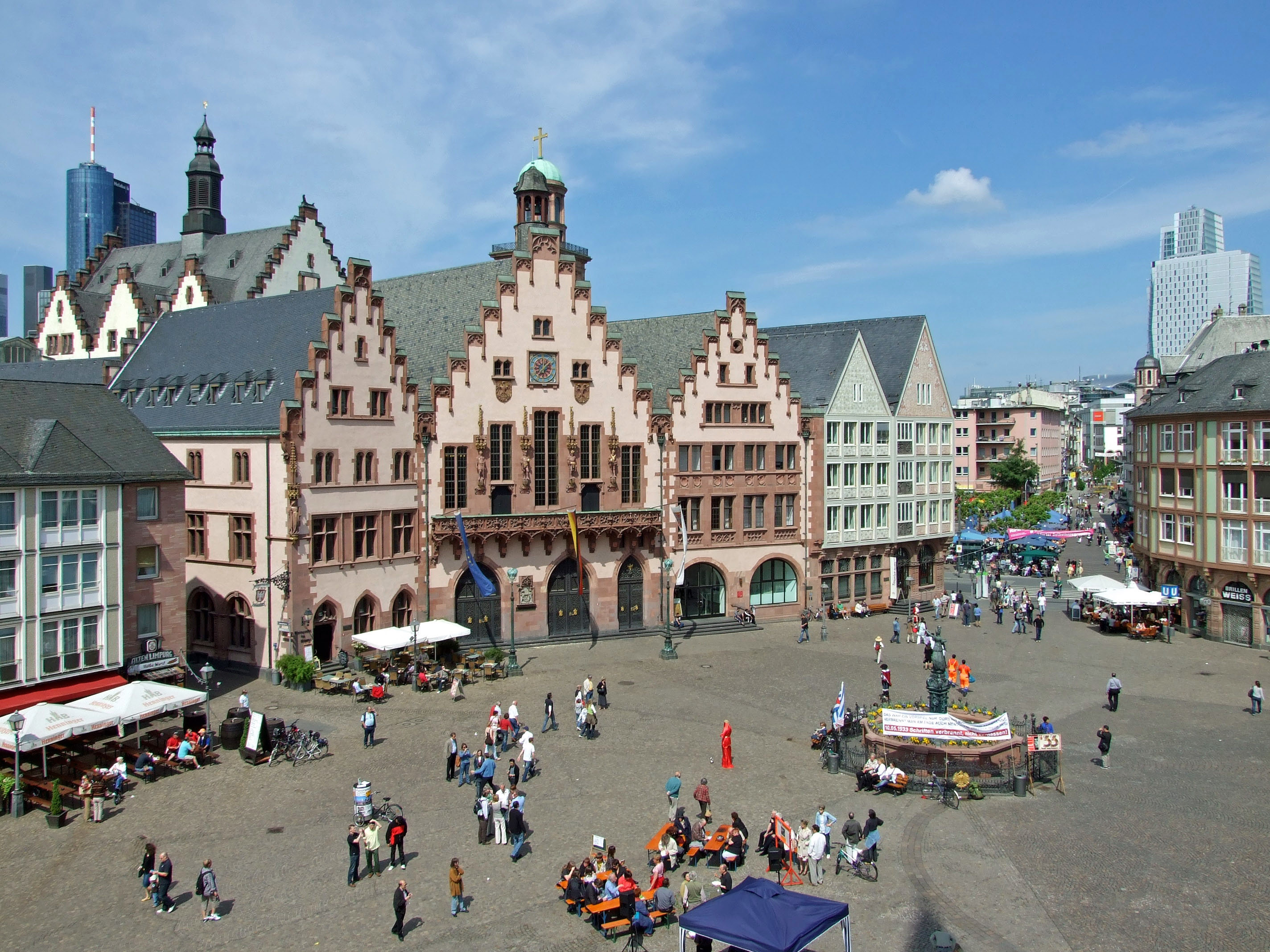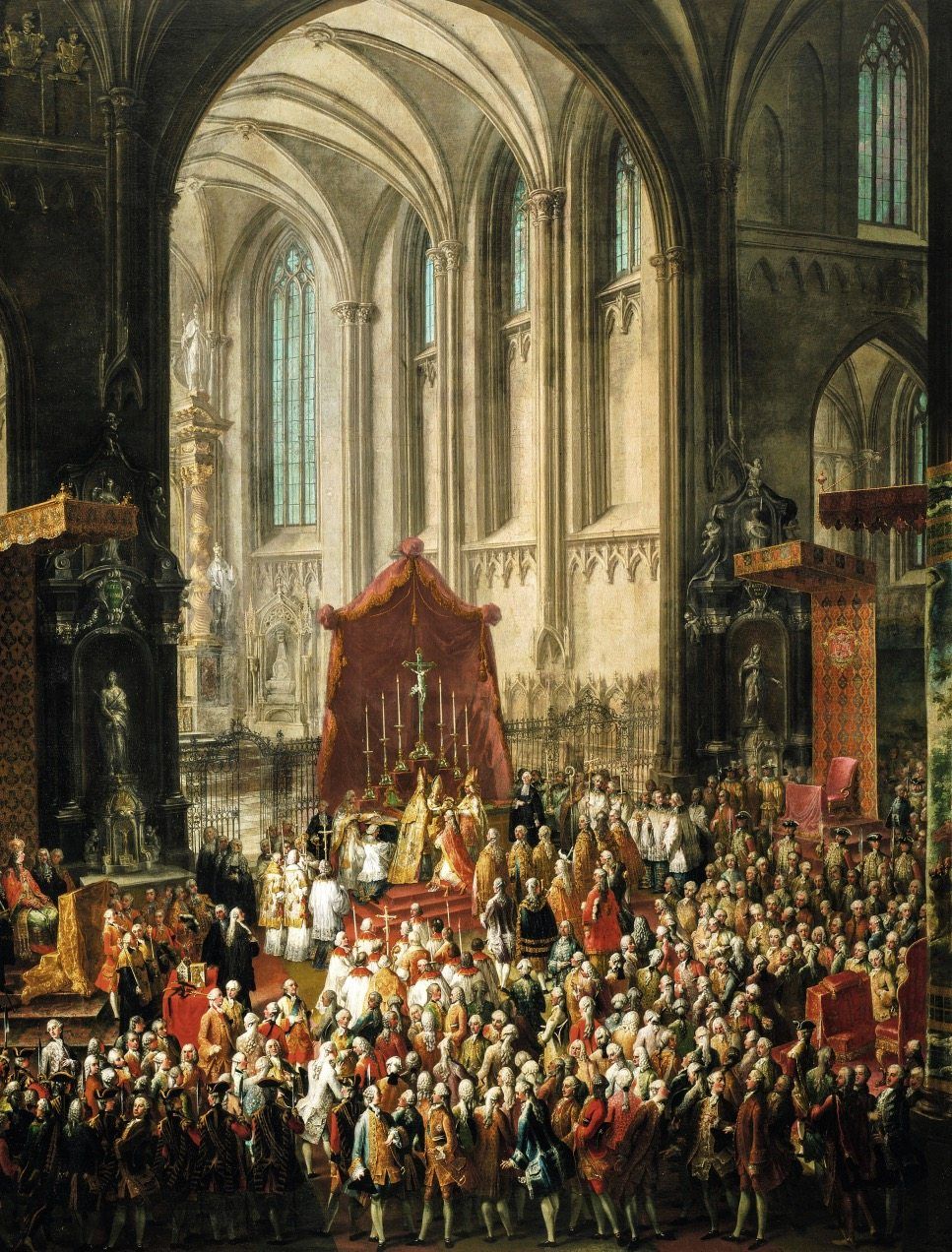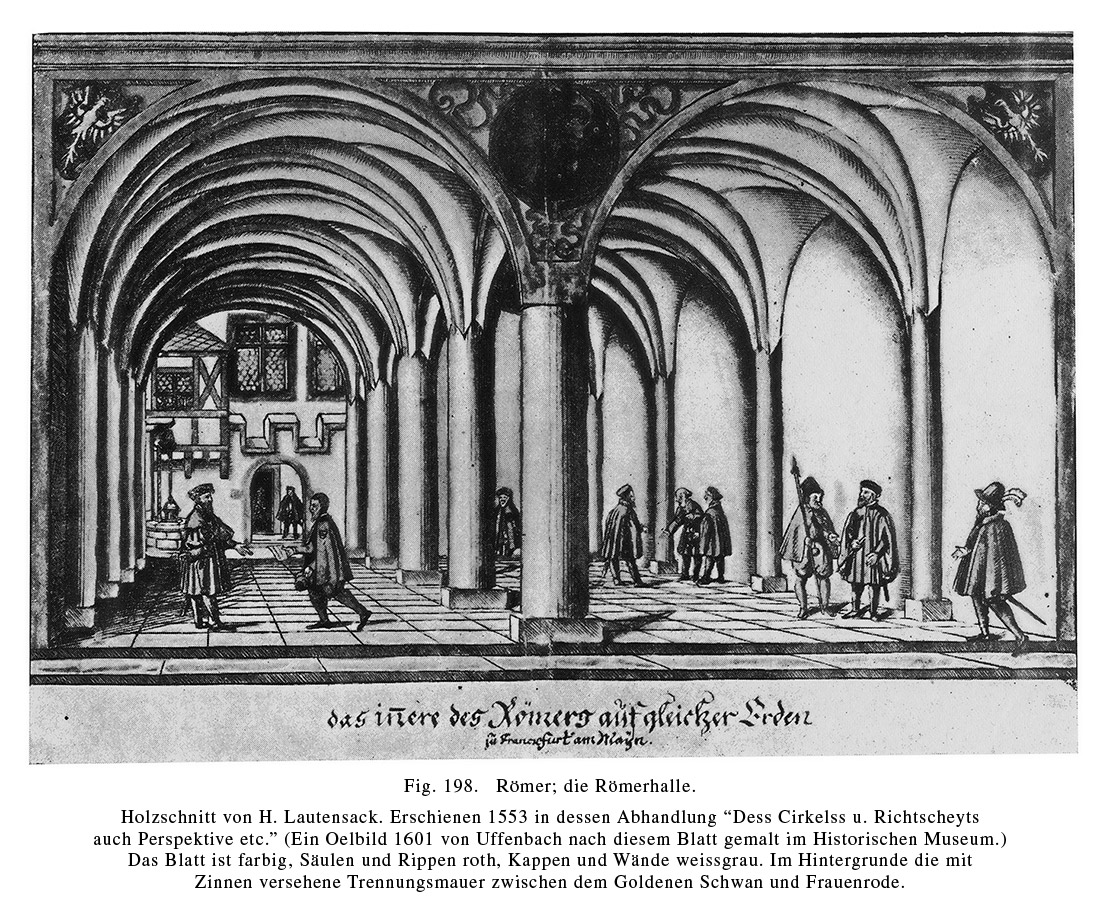|
Kunsthalle Schirn
The Schirn Kunsthalle is a Kunsthalle in Frankfurt, Germany, located in the old city between the Römer and the Frankfurt Cathedral. The Schirn exhibits both modern and contemporary art. It is the main venue for temporary art exhibitions in Frankfurt. Exhibitions included retrospectives of Wassily Kandinsky, Marc Chagall, Alberto Giacometti, Bill Viola, and Yves Klein. The Kunsthalle opened in 1986 and is financially supported by the city and the state. Historically, the German term "Schirn" denotes an open-air stall for the sale of goods, and such stalls were located here until the 19th century. The area was destroyed in 1944 during the Second World War and was not redeveloped until the building of the Kunsthalle. As an exhibition venue, the Schirn enjoys national and international renown, which it has attained through independent productions, publications, and exhibition collaborations with museums such as the Centre Pompidou, the Tate Gallery, the Solomon R. Guggenheim M ... [...More Info...] [...Related Items...] OR: [Wikipedia] [Google] [Baidu] |
Römerberg (Frankfurt)
Römerberg (also spelled as ''Roemerberg'', ) is a public space in Frankfurt, Germany. It is located in front of the Römer building complex, seat of the Frankfurt city administration since the 15th century. As the site of numerous imperial coronations, trade fairs and Christmas markets, the square is the historic heart of the medieval Altstadt (old town) and today a popular tourist destination. Paulsplatz, another historic square, is to the north. The Old St Nicholas Church and Historical Museum are to the south. Beyond that is the , a promenade by the River Main. On the west side of the square is the reconstructed Römer medieval building. To the east is the Dom-Römer Project, and beyond that is Frankfurt Cathedral. Römerberg is a major location for the outdoor Frankfurt Christmas Market. It was the site of a Nazi book burning The Nazi book burnings were a campaign conducted by the German Student Union (, ''DSt'') to ceremonially Book burning, burn books in Nazi Ge ... [...More Info...] [...Related Items...] OR: [Wikipedia] [Google] [Baidu] |
Museum Giersch
The Museum Giersch is an art gallery on the Main River in Frankfurt am Main, Germany, in the Museumsufer area. The museum opened in 2000. It hosts a changing series of exhibitions displaying the art and cultural history of the Rhine-Main area, with the aim of promoting the region's cultural identity.Museums City of Frankfurt am Main. The Museum Giersch displays works on loan from public and private collections. The range of exhibits covers all areas of painting, photography, sculpture and , as well as architecture and . The gallery is situated in a ... [...More Info...] [...Related Items...] OR: [Wikipedia] [Google] [Baidu] |
Marc Chagall
Marc Chagall; russian: link=no, Марк Заха́рович Шага́л ; be, Марк Захаравіч Шагал . (born Moishe Shagal; 28 March 1985) was a Russian-French artist. An early modernism, modernist, he was associated with several major art movement, artistic styles and created works in a wide range of artistic formats, including painting, drawings, book illustrations, stained glass, stage sets, ceramics, tapestries and fine art prints. Born in the Russian Empire, today Belarus, he was of Russian Jews, Jewish origin. Before World War I, he travelled between Saint Petersburg, Paris, and Berlin. During this period he created his own mixture and style of modern art based on his idea of Eastern Europe and Jewish folk culture. He spent the wartime years in Belarus, becoming one of the country's most distinguished artists and a member of the modernist avant-garde, founding the Vitebsk Museum of Modern Art, Vitebsk Arts College before leaving again for Paris in 1923 ... [...More Info...] [...Related Items...] OR: [Wikipedia] [Google] [Baidu] |
Wassily Kandinsky
Wassily Wassilyevich Kandinsky (; rus, Василий Васильевич Кандинский, Vasiliy Vasilyevich Kandinskiy, vɐˈsʲilʲɪj vɐˈsʲilʲjɪvʲɪtɕ kɐnʲˈdʲinskʲɪj; – 13 December 1944) was a Russian painter and art theorist. Kandinsky is generally credited as one of the pioneers of abstraction in western art, possibly after Hilma af Klint. Born in Moscow, he spent his childhood in Odessa, where he graduated at Grekov Odessa Art School. He enrolled at the University of Moscow, studying law and economics. Successful in his profession—he was offered a professorship (chair of Roman Law) at the University of Dorpat (today Tartu, Estonia)—Kandinsky began painting studies (life-drawing, sketching and anatomy) at the age of 30. In 1896, Kandinsky settled in Munich, studying first at Anton Ažbe's private school and then at the Academy of Fine Arts. He returned to Moscow in 1914, after the outbreak of World War I. Following the Russian Revolu ... [...More Info...] [...Related Items...] OR: [Wikipedia] [Google] [Baidu] |
Art Exhibition
An art exhibition is traditionally the space in which art objects (in the most general sense) meet an audience. The exhibit is universally understood to be for some temporary period unless, as is rarely true, it is stated to be a "permanent exhibition". In American English, they may be called "exhibit", "exposition" (the French word) or "show". In UK English, they are always called "exhibitions" or "shows", and an individual item in the show is an "exhibit". Such expositions may present pictures, drawings, video, sound, installation, performance, interactive art, new media art or sculptures by individual artists, groups of artists or collections of a specific form of art. The art works may be presented in museums, art halls, art clubs or private art galleries, or at some place the principal business of which is not the display or sale of art, such as a coffeehouse. An important distinction is noted between those exhibits where some or all of the works are for sale, normally in pr ... [...More Info...] [...Related Items...] OR: [Wikipedia] [Google] [Baidu] |
Frankfurt Cathedral
Frankfurt Cathedral (german: link=no, Frankfurter Dom), officially Imperial Cathedral of Saint Bartholomew (german: link=no, Kaiserdom Sankt Bartholomäus) is a Roman Catholic Gothic church located in the heart of Frankfurt am Main, Germany. It is dedicated to Saint Bartholomew. It is the largest religious building in the city and a former collegiate church. Despite its common English name, it has never been a true cathedral (episcopal see), but is called the ''Kaiserdom'' (an "imperial great church" or imperial cathedral) or simply the ''Dom'' due to its importance as former election and coronation church of the Holy Roman Empire. As one of the major buildings of the Empire's history, it was a symbol of national unity, especially in the 19th century. The present church building is the third church on the same site. Since the late 19th century, excavations have revealed buildings that can be traced back to the seventh century. The history is closely linked with the general hist ... [...More Info...] [...Related Items...] OR: [Wikipedia] [Google] [Baidu] |
Römer
The Römer (German surname, "Roman") is a medieval building in the Altstadt of Frankfurt am Main, Germany, and one of the city's most important landmarks. The Römer is located opposite the Old St. Nicholas church and has been the city hall (''Rathaus'') of Frankfurt for over 600 years. The Römer merchant family sold it together with a second building, the ''Goldener Schwan'' (Golden Swan), to the city council on 11 March 1405 and it was converted for use as the city hall. The ''Haus Römer'' is actually the middle building of a set of three located in the ''Römerberg'' plaza. The ''Römer'' is not a museum as it is occasionally used by the city for various purposes, for example as a ''Standesamt'' or civil registration office; the wedding rooms are located in the first and second floor of the ''Haus Löwenstein''. The former old town quarter between the Römer and St. Bartholomew's Cathedral has been redeveloped as the Dom-Römer Quarter until 2018, including several rec ... [...More Info...] [...Related Items...] OR: [Wikipedia] [Google] [Baidu] |
Frankfurt
Frankfurt, officially Frankfurt am Main (; Hessian: , "Frank ford on the Main"), is the most populous city in the German state of Hesse. Its 791,000 inhabitants as of 2022 make it the fifth-most populous city in Germany. Located on its namesake Main River, it forms a continuous conurbation with the neighboring city of Offenbach am Main and its urban area has a population of over 2.3 million. The city is the heart of the larger Rhine-Main metropolitan region, which has a population of more than 5.6 million and is Germany's second-largest metropolitan region after the Rhine-Ruhr region. Frankfurt's central business district, the Bankenviertel, lies about northwest of the geographic center of the EU at Gadheim, Lower Franconia. Like France and Franconia, the city is named after the Franks. Frankfurt is the largest city in the Rhine Franconian dialect area. Frankfurt was a city state, the Free City of Frankfurt, for nearly five centuries, and was one of the most import ... [...More Info...] [...Related Items...] OR: [Wikipedia] [Google] [Baidu] |
Frankfurter Judengasse
The Frankfurter Judengasse ("Jews' Lane" in German) was the Jewish ghetto of Frankfurt and one of the earliest ghettos in Germany. It existed from 1462 until 1811 and was home to Germany's largest Jewish community in early modern times. At the end of the 19th century, most of the buildings in the Judengasse were demolished. The area suffered major destruction during World War II and reconstruction left no visible signs of the ghetto in today's townscape of Frankfurt. Post-war usage of the area included a car park, a petrol station and a wholesale flower market. The decision to build an administrative complex triggered a public discussion as to what should be done with the archaeological remains uncovered during the excavation in 1977. The foundations of 19 buildings were found and five of these can be seen at the "Museum Judengasse" which was incorporated into the new building. Location The ghetto was located outside the city walls east of the medieval city wall (Staufenma ... [...More Info...] [...Related Items...] OR: [Wikipedia] [Google] [Baidu] |
Museum Für Moderne Kunst
The Museum für Moderne Kunst (''Museum of Modern Art''), or short MMK, in Frankfurt, was founded in 1981 and opened to the public 6 June 1991. The museum was designed by the Viennese architect Hans Hollein. Because of its triangular shape, it is popularly called "piece of cake", Claes Oldenburg artistically has expressed in a work. History The newest of Frankfurt's museums was founded in 1981. The idea to set up a museum for modern art in Frankfurt came from Peter Iden, an influential theatre and art critic at the Frankfurter Rundschau and founding director of the museum (1978–1987). With the Mayor Walter Wallmann (CDU) and the Head of the Cultural department Hilmar Hoffmann (SPD) Iden found political advocates for his project. In 1989, the Swiss art historian and curator Jean-Christophe Ammann moved from the Kunsthalle Basel to Frankfurt am Main and opened the new Museum für Moderne Kunst (MMK) Frankfurt am Main there on 6 June 1991. With a new exhibition model, the Change ... [...More Info...] [...Related Items...] OR: [Wikipedia] [Google] [Baidu] |
Historical Museum, Frankfurt
The Historical Museum (German: Historisches Museum) in Frankfurt am Main, Germany, was founded in 1878, and includes cultural and historical objects relating to the history of Frankfurt and Germany. It moved into the Saalhof in 1955, and a new extension was opened in 1972. The 1970s extension is currently being replaced by a modern new exhibition building and a small administration building which are expected to be completed by 2015. Collection The museum's collection is displayed in several permanent chronological exhibitions: Mediaeval Frankfurt, the Late Middle Ages, the sixteenth to eighteenth centuries, the nineteenth-century city, and its history as a metropolis from 1866 to 2001. Special exhibitions are also on display. Important artworks File:HMF Altar Hl Anna DSC 1505 6321.jpg, '' St. Anne altarpiece'' from the Carmelite church in Frankfurt, c.1500 by the Master of Frankfurt File:HMF Duerer Gruenewald Harrich Heller-Altar DSC 6312.jpg, The ''Heller Altarpice (1508) f ... [...More Info...] [...Related Items...] OR: [Wikipedia] [Google] [Baidu] |







